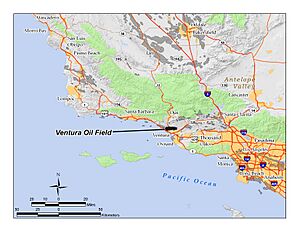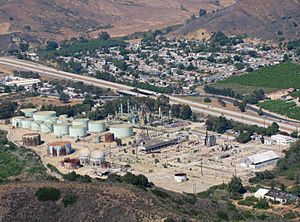Ventura Oil Field facts for kids
The Ventura Oil Field is a very large place where oil is found deep underground. It's located in the hills just north of the city of Ventura in southern California. This oil field is quite long, about 8 miles (13 km), and about 2 miles (3.2 km) wide.
Oil was first discovered here in 1919. Since then, it has produced over 1 billion barrels of oil! That's a huge amount. It's one of the biggest oil fields in California. As of 2023, it still had about 50 million barrels of oil left and 423 wells were still pumping oil. A company called Aera Energy LLC operates the entire field.
Where is the Ventura Oil Field?
This oil field sits on and under the hills around the city of Ventura. The Ventura River flows right through the middle of the field, coming from Ojai and heading to the Pacific Ocean. The hills are covered with chaparral plants and coastal sage scrub. Along the river, you'll find riparian woodlands, which are forests near water.
The land here is very steep. Roads wind back and forth to reach the oil wells and storage tanks. Most of the oil field is hidden from the city by the first set of hills. This oil field is part of a group of oil fields that follow the direction of the Transverse Ranges mountains.
A main road, California State Route 33, goes through the oil field, following the Ventura River. This road helps people get to different parts of the field. The weather here is like a Mediterranean climate. This means cool, rainy winters and mild, dry summers. Ocean clouds often keep it cool in the mornings. The elevation ranges from about 40 feet (12 m) near the river to about 1,200 feet (366 m) on the highest hills.
How Oil Formed Here
The main reason oil collects in the Ventura field is a large underground rock fold called the Ventura Anticline. Imagine a long house with a gabled roof; that's what this rock structure looks like underground. Oil and gas get trapped in this "roof." This anticline is about 16 miles (26 km) long.
Most of the oil is found in a rock layer called the Pico Formation. This layer is made of sandy sedimentary rock that has many tiny spaces where oil can collect. Oil is also found in the Santa Margarita Formation below it. Scientists have found eight different oil-rich areas, called "zones," at different depths. The deepest zones are over 12,000 feet (3,658 m) underground!
The oil in the Ventura field likely came from an even deeper rock layer called the Monterey Formation. This formation is rich in ancient organic matter, like tiny plants and animals. Over millions of years, this matter turned into oil. The oil then slowly moved upwards and got stuck in the folds and traps of the Ventura Anticline. Some oil zones are even sealed by a fault line, which is like a crack in the Earth's crust, that acts as an extra trap.
Because of these natural traps, there were many places where tar would naturally seep out of the ground. The native Chumash people used this tar to seal their boats long ago.
History of Oil Production
People first started exploring for oil here in 1885. In 1903, a company drilled seven shallow gas wells. The first well that produced oil in a useful amount was drilled in May 1916. It produced about 100 barrels of oil each day. In March 1919, the Shell Oil Company drilled the first well into one of the main oil zones.
The discovery of oil led to a big boom in Ventura in the 1920s. More people moved to the city, and new roads were built, making it easier to travel to places like Los Angeles and Santa Barbara.
Drilling for oil in Ventura was always a challenge. The oil was very deep, and the rock layers were difficult to work with. In 1928, one well, called Lloyd No. 102, was the deepest producing oil well in the world at the time, pumping oil from 7,210 feet (2,198 m) down. Later, other wells went even deeper. The oil from these deep areas was extremely hot, sometimes around 300°F (149°C)!
The Ventura Oil Field produced the most oil in the 1950s. In 1954 alone, it produced over 31 million barrels of oil. As production started to slow down, new methods were used to get more oil out. One method is called "waterflooding." This is when water is pumped into the oil reservoir to push the remaining oil towards the wells, making it easier to extract. This method is still used today.
Today, Aera Energy LLC operates the entire field. This company is a partnership between ExxonMobil and Shell Oil Co.. In 2009, Aera was still producing about 11,600 barrels of oil every day from the field. By 2016, they reported producing 14,000 barrels of crude oil and a lot of natural gas daily from 414 wells. In 2022, Shell and ExxonMobil agreed to sell Aera's assets to another company.






